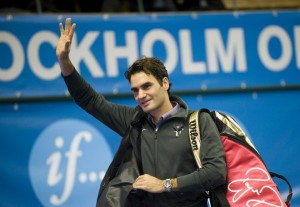Much was made of Roger Federer’s 900th career ATP World Tour singles match Thursday – a 6-1, 6-2 win in 50 minutes over American Taylor Dent at the Stockholm Open in Sweden. But who did Federer play and what were the circumstances in his first ATP match?
Rene Stauffer, the author of the celebrated Federer book ROGER FEDERER: QUEST FOR PERFECTION ($19.95, New Chapter Press, www.RogerFedererBook.com) discusses Federer’s ATP debut in Gstaad, Switzerland in 1998 in this exclusive book excerpt below:

As a reward for winning the Wimbledon junior title, Federer received a wild card entry into the Swiss Open in Gstaad from tournament director Köbi Hermenjat. Federer received his first chance to play in an ATP tournament, even though he was not qualified to play since his world ranking stood at No. 702. Gstaad, the clay court tournament that traditionally takes place the week after Wimbledon, is played in a picturesque jet-set vacation area in the Bernese Alps. It is one of the oldest professional tournaments with a history dating back to 1915. It is loved by players and spectators alike because of its idyllic location in the little village with many chalets, the majestic Palace Hotel—whose courts previously hosted the tournament—and its postcard ambiance. Hermenjat was one of the most senior tournament directors on the ATP Tour and well acquainted with everyone in the tennis world. He embodied a piece of tennis history. He was a ball boy for the tournament when he was 11 years old and had been the tournament director since 1965. Tennis legends such as John Newcombe, Tony Roche, Ilie Nastase, Ken Rosewall and Roy Emerson—after whom later the Centre Court was named—are all past champions of the Swiss Open.
Federer very reluctantly declined taking part in the traditional and prestigious Wimbledon Champions Dinner and left London that Sunday. He flew to Basel and continued by automobile to the Bernese Alps. It was well after midnight when he arrived at the luxury resort.
Federer’s ATP tournament debut proved difficult. At Wimbledon, he played on grass courts and almost at sea level. In Gstaad, he found himself on slippery clay courts and at over 3,000 feet above sea level. At Wimbledon, the balls bounced low, but in the high air at Gstaad, the balls bounced high and fast. The clay surface also demanded a completely different running technique than on grass. At Wimbledon, he competed against inexperienced junior players. An array of world class players were in the draw at Gstaad. There was no doubt that the tournament was a few sizes too big for him. His purpose, however, was just to gather some experience and be presented, on this grander sporting stage, to a larger portion of the Swiss public.
Federer drew German Tommy Haas, ranked No. 41 in the world rankings, as his first-round opponent, scheduled to play on Tuesday, the second day of the tournament. On Monday, due to great demand, Federer held a press conference to discuss his Wimbledon junior success and his ATP debut. “I would have preferred to play on the Centre Court than on the secondary court,” he said confidently of where the Gstaad tournament officials chose to schedule his match. There was so much interest in the Wimbledon junior champion that the thousand seats in the grandstands at Court No. 1 in Gstaad were not enough to accommodate the storm of spectators. As it turned out, Tommy Haas was not Federer’s opponent. The German withdrew from the tournament a few minutes before match time due to stomach trouble. Lucas Arnold, a lucky loser from the qualifying tournament, was Federer’s opponent. The Argentine clay court expert, ranked No. 88 in the world, defeated Federer 6-4, 6-4, but Arnold admitted that he was impressed by the 16-year-old, saying “he plays like Pete Sampras and he has a great serve.”
Federer was disappointed but he had no reason to be crushed. “I competed very hard, but did not play well. If I had played well, I would have won,” he said in an upbeat tone. “You have to do more running with the professionals than with the juniors and pros are not going to make as many mistakes.”
